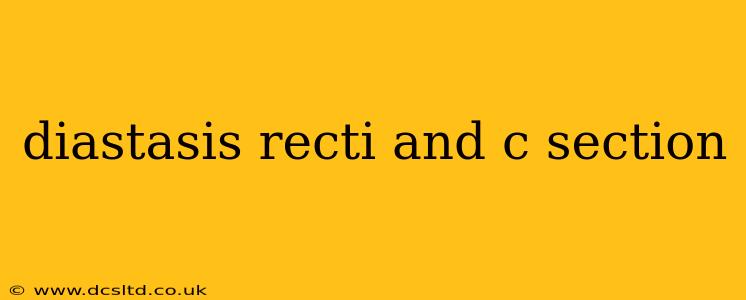Diastasis recti, the separation of the abdominal muscles, is a common postpartum condition affecting many new mothers. While it can occur after vaginal delivery, there's a significant question surrounding its connection to Cesarean sections (C-sections). This article explores the relationship between diastasis recti and C-sections, addressing common concerns and providing valuable information for expectant and postpartum mothers.
What is Diastasis Recti?
Diastasis recti abdominis (DRA) refers to the widening of the linea alba, the connective tissue that runs down the middle of your abdomen, separating your right and left rectus abdominis muscles (the "six-pack" muscles). This separation can range from a slight gap to a significant widening, often causing a bulging or doming appearance in the abdomen. It's crucial to understand that DRA isn't necessarily a "muscle tear," but rather a stretching and weakening of the connective tissue.
Can a C-Section Cause Diastasis Recti?
While often associated with vaginal delivery, diastasis recti can also occur after a C-section. However, the mechanisms and prevalence differ. Vaginal delivery puts significant strain on the abdominal muscles during pushing. With C-sections, the abdominal muscles are incised during surgery, and the recovery process can contribute to the weakening of the linea alba. The hormonal changes associated with pregnancy, which soften connective tissue throughout the body, also play a significant role regardless of delivery method.
Therefore, the answer is yes, a C-section can contribute to diastasis recti, but it's not the sole cause. The hormonal changes of pregnancy are the primary driver, and factors like pre-pregnancy abdominal muscle strength and overall body composition also play a role.
Is Diastasis Recti More Common After a C-Section Than a Vaginal Delivery?
Studies show conflicting results regarding the prevalence of diastasis recti after C-sections versus vaginal deliveries. Some research suggests a similar incidence rate between the two delivery methods. Other studies have indicated a slightly lower incidence after C-sections, possibly due to the reduced strain on abdominal muscles during childbirth. More research is needed to definitively answer this question, as factors like individual variation, pre-pregnancy fitness, and postpartum recovery practices significantly influence the development of DRA.
How Can I Tell if I Have Diastasis Recti After a C-Section?
Self-checking for diastasis recti is possible. Lie on your back with your knees bent and feet flat on the floor. Gently place your fingertips on your abdomen, just above your belly button. Lift your head slightly, as if performing a crunch, and feel for a separation or bulging between your abdominal muscles. Repeat this below your belly button. A separation of more than two finger-widths is generally considered a significant diastasis recti. However, a professional assessment by a physical therapist specializing in postpartum recovery is recommended for accurate diagnosis and personalized treatment.
How is Diastasis Recti Treated After a C-Section?
Treatment for diastasis recti after a C-section is similar to treatment after a vaginal delivery and generally focuses on gentle exercises and specific physical therapy techniques. A qualified physical therapist can assess the severity of the separation, guide you on appropriate exercises, and provide guidance on proper posture and movement to support healing. It is crucial to avoid high-impact activities or strenuous abdominal exercises until your linea alba has had sufficient time to heal. Surgical repair may be an option in severe or persistent cases that do not respond to conservative management. Always consult with your healthcare provider or a qualified physical therapist before beginning any exercise program.
When Should I Seek Professional Help for Diastasis Recti After a C-Section?
If you suspect you have diastasis recti after a C-section, it's essential to seek professional help. A physical therapist can diagnose the severity of the separation, provide personalized treatment options, and teach you exercises to strengthen your core muscles safely and effectively. They can also address associated symptoms like back pain or pelvic floor dysfunction. Don't hesitate to consult with your healthcare provider or a physical therapist, especially if you experience significant abdominal discomfort, pain, or functional limitations. Early intervention often leads to more effective treatment and faster recovery.
Disclaimer: This information is for educational purposes only and should not be considered medical advice. Always consult with a healthcare professional for any health concerns or before making any decisions related to your health or treatment.
